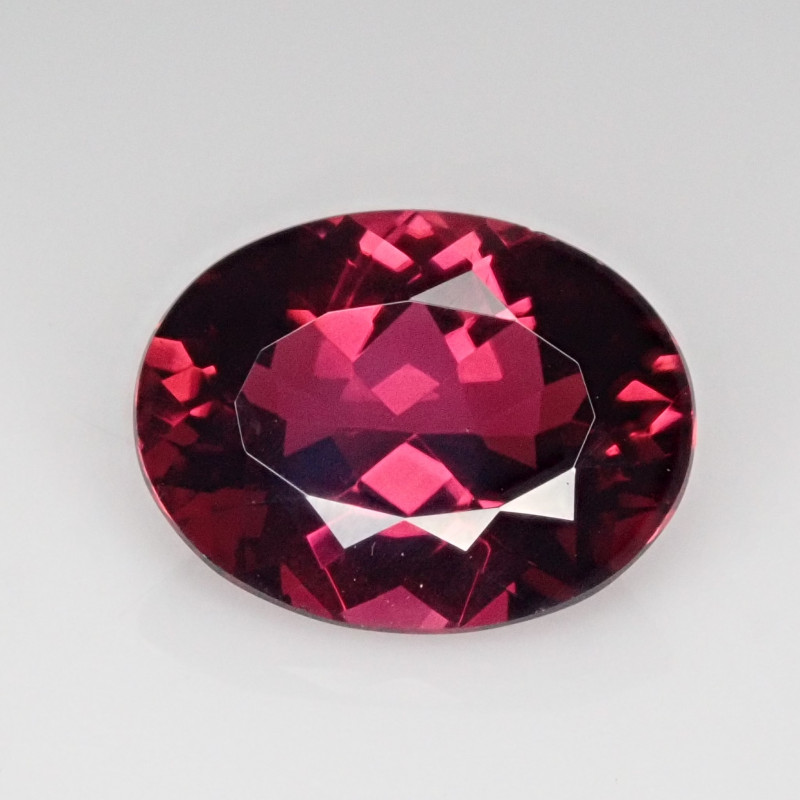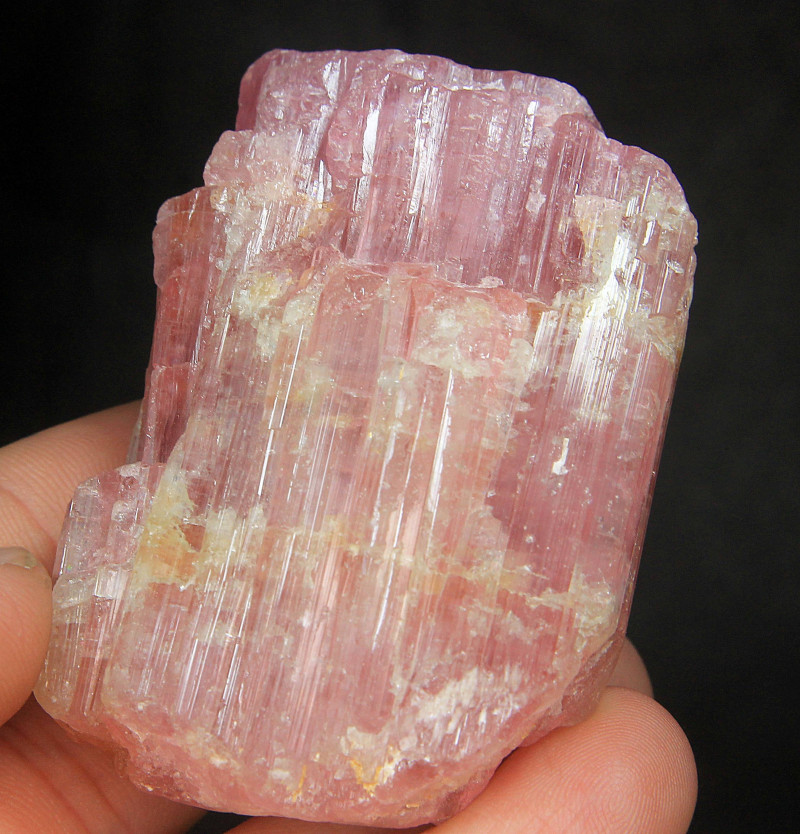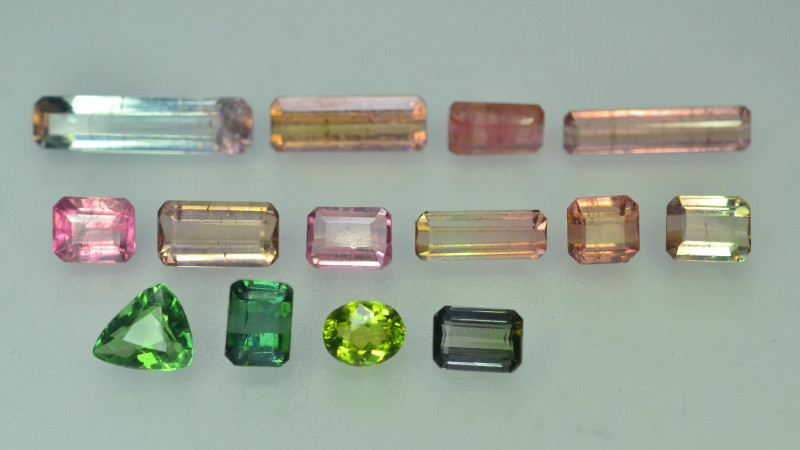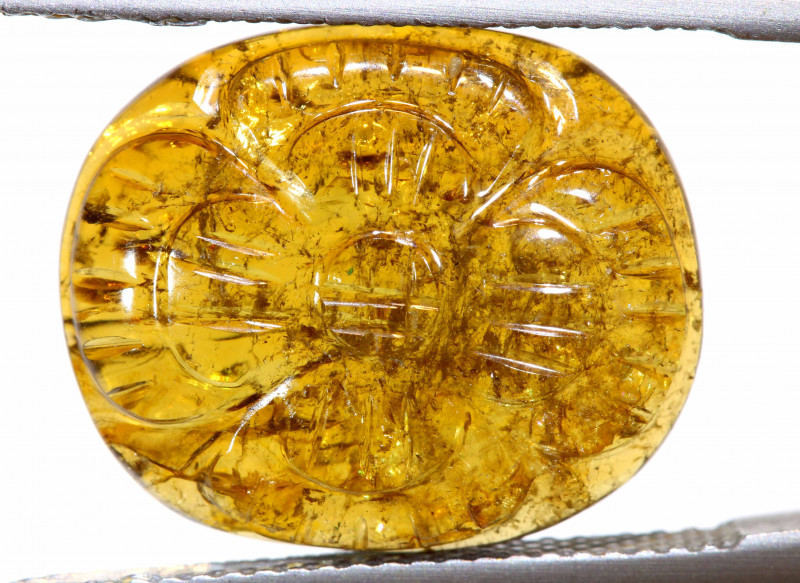
Tourmaline Gemstone: Properties, Meanings, Value & More
 Tourmaline describes a group of silicate minerals with highly similar crystal structures but widely varied chemical compositions. The tourmaline stone is known for having one of the broadest color ranges of any gemstone family!
Tourmaline describes a group of silicate minerals with highly similar crystal structures but widely varied chemical compositions. The tourmaline stone is known for having one of the broadest color ranges of any gemstone family!
Some claim tourmaline is the national gemstone of the USA, though this isn’t officially confirmed. However, the US state of Maine named tourmaline their official state mineral in 1971 after the gorgeous tourmaline specimens found there.
So what makes tourmaline so diverse? And is tourmaline an expensive gem? We’ll answer all your burning questions in this tourmaline gemstone guide!

About Tourmaline Stone
Tourmaline is a semi-precious gemstone with a color to suit every personality. Because of their impressive color range, ancient legends claim tourmalines traveled on a rainbow and collected all its colors.
Another stone known for its rainbow-like hues is the opal, which happens to join tourmaline as an October birthstone!
Any astrology lovers out there? Tourmaline is Libra’s zodiac stone! As the sign of balance, Libras will love tourmaline’s wide variety. Some Libras might lean toward pink or red; after all, they’re ruled by Venus, the planet of love.
Did someone say love? Tourmaline is the traditional gemstone to commemorate your 8th wedding anniversary! Tourmaline jewelry is the perfect gift to celebrate, and those looking for a more masculine option can find handsome black tourmaline jewelry as well.
Mineral Characteristics
Tourmaline gemstones are a boron silicate mineral, though, the term tourmaline also refers to a group of minerals with widely varied compositions.
The reason for tourmaline’s varied compositions is isomorphous replacement, a process where some silicon is replaced by other elements, but the crystal structure stays the same.
The most common elements added through isomorphous replacement are aluminum, magnesium, iron, and copper. The range of chemical compositions means some tourmaline mineral properties (like color, refractive index, and density) may differ between stones.
On the Mohs mineral hardness scale, tourmalines range from 7 to 7.5, making them slightly harder than quartz.
One common property among all tourmalines is pyroelectricity and piezoelectricity. P-what? The processes involve conducting electricity under heat or pressure, respectively. Some tourmalines show impressive magnetism, caused by the presence of iron and/or manganese.
Did you know that tourmaline encompasses 30+ minerals? So, which tourmaline species are important to know? Keep reading to find out!
Tourmaline Varieties
The first key categories are tourmaline’s most common species: schorl, dravite, and elbaite.

Schorl
The most common tourmaline species, schorl is sodium- and iron-rich and makes up at least 95% of natural tourmaline. Named after the former title of German village Zschorlau, schorl is brown to black, and includes the popular black tourmaline.

Dravite
Named after the European Drava river locale, dravite contains sodium and magnesium. It may go by “brown tourmaline,” though its colors include dark red, yellow, light cyan, deep green, yellow, black, and even colorless.

Elbaite
Elbaite is the most common gem-quality species and contains lithium, sodium, and aluminum. Named after Italy’s Elba Island, elbaite may be colorless, red, pink, blue, green, or a combination of colors.
Within each species are plenty of distinct varieties, but here are the primary ones you’ll see on the market:
Chrome Tourmaline: Tanzania’s rare vivid-green dravite variety.
Indicolite: Predominantly blue elbaite variety from Brazil found in light and dark shades.
Paraíba Tourmaline: Brazil’s intensely saturated neon-blue to blue-green or violet elbaite variety that’s often heavily included.
Rubellite: Saturated pink to ruby-red variety that may have purple, brown, or orange undertones and are usually elbaites.
Sunset Tourmaline: A gorgeous gradient of pink and orange that mimics the sunset
Verdelite: Green elbaite variety often called “Brazilian emerald” or “Ceylonese peridot” for its source and color-resemblance.
Watermelon Tourmaline: Bi-colored pink and green elbaite variety, typically with a pink center and green border, sometimes separated with a colorless layer between the two.
Now that we’ve covered the different types of tourmaline gemstones, let’s go over the stone’s mineral characteristics.
Tourmaline Specifications & Characteristics
Color: Solid, mixed, or zoned shades of black, brown, blue, yellow, green, red, pink, orange, violet, and colorless
Crystal structure: Trigonal
Luster: Vitreous (glass-like)
Transparency: Translucent to opaque
Refractive index: 1.61-1.65 or 1.63-1.68
Density: 2.82-3.32
Cleavage: Indistinct
Fracture: Uneven or conchoidal
Streak: White
Luminescence: Fluorescence in pink stones; Inert to very weak; Red to violet in LW and SW
Pleochroism: Present, usually moderate to strong; May be dichroic; Colors and strength varies by stone:
Red stones: Moderate, dark to light red
Green stones: Strong, dark green to yellow-green
Brown stones: Moderate, dark to light brown
Blue: Strong, dark to light blue
Phew, lots of science! Switching gears, what is the meaning of tourmaline stone?

Tourmaline Meaning
The name “tourmaline” comes from the Sinhalese tōramalli, meaning either “mixed-colored gems” or “carnelian,” depending who you ask.
Sinhalese is a Sri Lankan language, but the term came from Dutch merchants describing the colorful stones they came across in Sri Lankan gem parcels.
The Dutch also created the nickname ashentrekkers, or “ash-attractor,” as they used magnetic tourmaline to draw up ash from pipes.
What does tourmaline symbolize? Generally, tourmaline symbolizes understanding, compassion, and open-mindedness.
Literature from the 1700s claims tourmaline benefits those in creative fields. One Dutch scientist during this era popularized wrapping tourmaline in silk and placing it on a sick child’s cheek to help them sleep.
Other cultural interpretations of tourmaline crystal meaning revolved around spiritual insight. Ancient ceremonies in India involved tourmaline to access insight and wisdom from higher powers, especially for differentiating good from evil.
Similarly, ancient Africans used tourmaline to uncover the hidden cause behind particular issues. Modern indigenous tribes in Africa, America, and Australia use tourmaline as a protective talisman or funeral gifts.
Speaking of modern uses, what are tourmaline stones used for now?

Tourmaline Healing Properties
All gemstones offer spiritual vibrations that make them healing crystals, but tourmaline’s numerous colors and properties mean there’s a tourmaline stone out there for virtually any problem!
What is tourmaline good for? In general, tourmaline properties provide protection, balance, and positivity!
For specific areas, what healing powers does tourmaline have?
Physical Healing
Tourmaline is a balancing stone for the body, from purportedly increasing hand-eye coordination to syncing brain hemispheres. This healing gem may also boost nervous system function.
Additionally, tourmaline is said to strengthen bones and improve overall vitality, allowing you to do more of what you love!
Emotional Healing
Tourmaline can offer greater empathy and understanding. Called the “Stone of Reconciliation,” tourmaline may help you address resentment to move toward acceptance.
Besides resentment, tourmaline can purify negative feelings like anxiety and self-doubt, transforming these into serenity and confidence.
Chakra Healing
Tourmaline healing abilities can balance all chakras, but the heart and root chakras are especially attuned to tourmaline.
Rubellite and watermelon tourmaline are best for heart chakra healing, the center of love and spirituality. A blocked heart chakra can make you feel anxious and aimless, but using tourmaline to open this chakra can bring back joy and self-respect.
Black tourmaline attunes to the root chakra, where basic needs of safety and belonging lie. When your root chakra is blocked, insecurities and paranoia can creep in. Using a black tourmaline gemstone can balance the chakra, bringing you greater trust and connection to your purpose.
On the topic of trust, how do you know a tourmaline’s true value? Read on to find out!

Tourmaline Gemstone Properties
Determining gemstone quality requires examining the stone’s value factors. Tourmaline value is based on color, cut, clarity, carat weight, and treatments.
Color
Tourmaline is allochromatic, meaning its color comes from impurities. Besides impurities, tourmaline color may be caused by natural or lab-induced radiation.
Generally, iron and titanium lead to greens and blues. Manganese leads to reds, pinks, and yellows, though some yellow and pink tourmaline is colored by radiation.
Color-zoning (uneven color distribution) is common and may occur as two colors (bi-color,) three colors (tri-color,) or more than three colors (parti-color.)
Pleochroism (showing different colors at different angles) occurs in multiple tourmaline varieties. Green tourmalines often show impressive pleochroism, with the highest-valued specimens displaying saturated green and blue in either direction.
What is the rarest color of tourmaline?
Paraiba tourmaline is the rarest color, while pink and red are among the most abundant tourmaline gemstone colors (outside of schorl.)
Cut
Tourmaline gems can handle virtually any shape, including faceted and unfaceted cuts. Since tourmaline crystals grow to be long, the most common faceted cuts are slender and rectangular. Paraiba tourmalines are the highest-priced variety, so cutters often choose brilliant cuts like cushions or ovals for these stones.
Bi-colored stones like watermelon tourmaline are often sliced to best display the color-zoning. Heavily included tourmalines usually become carvings or cabochons to minimize inclusions and highlight their color.
Clarity
Gemstone clarity refers to the number of visible inclusions present in a stone. Colored gemstones fall under one of three clarity grades, but tourmaline grades may differ.
Most tourmalines fall under Type II. However, chrome tourmaline and other green varieties are under Type I, while rubellite, Paraiba, and watermelon tourmaline fall under Type III. Pink or red tourmalines are usually much more included than green or blue ones.
Common mineral inclusions include apatite, mica, zircon, and hornblende. Sometimes, tourmaline is an inclusion in other gems, like tourmaline quartz!
The type of inclusion you’ll most often see in tourmaline is thread-like cavities along the crystal’s length that may contain gas bubbles or liquid. Long, hollow tubes are common in tourmaline as well, and if a tourmaline gem contains lots of these tubes, it may display chatoyancy (cat’s eye.)
Carat Weight
Tourmaline crystals can be small, large, and anywhere in between. However, sizes above 5 cts are rarer and command higher prices.
The price-per-carat for faceted tourmaline gems increases with size. For example, a 1-ct stone may be, say, $300 per carat, while a 2-ct stone could be $500 per carat.
Tourmaline varieties vary in size, too. Paraiba tourmaline is almost never found larger than 1 ct, but chrome tourmaline is often found up to 5 cts.
Treatments
Tourmaline treatments are becoming increasingly common. The purpose of gemstone treatments is usually to alter color or hide fractures. Popular treatments include heating, irradiation, and fracture-filling.
Violet, blue, and green tourmalines often receive heat treatments to get a color closer to Paraiba tourmaline. Irradiation is often employed to turn rubellite brighter pink, while brownish-pink stones may be heat-treated first to reduce their saturation, then irradiated to be rose-red.
Cat’s-eye tourmalines sometimes undergo acid treatment to remove inclusions or stains along their “eye,” followed by fracture-filling with a paler substance.
While treatments are a somewhat modern practice, demand for colorful tourmalines goes much further back.

Tourmaline Stone History
The first recorded discovery of tourmaline occurred in 1554 Brazil. Spanish conquistador Francisco Spinoza found a green gem he called “Brazilian emerald” that would later be identified as green tourmaline.
Evidence suggests tourmaline trade happened before Spinoza’s discovery, however, as Dutch merchants traded schorl around the 1400s (if not earlier.) Dutch merchants also traded Sri Lankan tourmaline, originating the stone’s name.
Soon, the Dutch East India Company brought huge parcels of Sri Lankan (or Ceylonese, at the time) tourmaline to Europe, believing the stone was colored zircon. As folks learned about tourmaline’s magnetic abilities, the stone gained the nickname “Ceylonese Magnet.”
Despite its early popularity, tourmaline didn’t gain official recognition as a distinct mineral until the 1800s. Besides this recognition, scientists also innovated new methods for using tourmaline. In 1861, John William Draper wrote about shining rays at fashioned tourmaline to polarize light.
American tourmaline deposits became popular in the late 1800s after soon-to-be Tiffany gemologist George F. Kunz commended Maine and California’s tourmalines. California became a leading source, exporting much of their supply to China for Chinese Dowager Empress Tz’u Hsi where the stones often became jewelry or carvings.
However, America stopped leading the tourmaline market after losing their Chinese market in 1912, so other nations like Brazil entered the market. In the 1980s, Brazilian miners discovered Paraiba tourmaline, securing Brazil as the top supplier for decades to come.
How did Brazil’s Paraiba tourmaline, along with other varieties, form in the first place?

Tourmaline Stone Origins & Sources
Like many gems, tourmaline crystal grows underground in pegmatite rocks. As magma heats groundwater, other minerals dissolve into the water and the solution fills crevices underground. Gradually, this solution cools and crystallizes into tourmaline.
Unlike most gems, tourmaline can grow into 3-sided prisms. Plus, some tourmalines are hemimorphic, meaning the crystal’s top and bottom are shaped differently.
Color-zoning in tourmalines — seen in watermelon, bi-color, and multi-colored tourmaline — occurs when the amount or type of trace elements change during formation.
Paraiba tourmaline formation is slightly unusual; scientists believe its dichroic colors are caused by large concentrations of manganese and copper. Of all tourmaline varieties, Paraiba is seemingly the only type colored by copper.
After it forms, where is tourmaline found?
Mining Locations
The most productive tourmaline source today is Brazil. Some locales worldwide have gained reputations for their varieties, like Brazil’s Paraiba tourmaline or Germany’s dravite species.
Where else does tourmaline come from?
Kenya
Madagascar
Mozambique
New Zealand
Nigeria
Pakistan
Russia
Scotland
Sri Lanka
Tanzania
United States (Maine, California, Colorado)
Zambia
Zimbabwe
Madagascar and Kenya are known for high-quality rubellite, while Afghanistan boasts vibrant cool-toned tourmaline, and Namibia produces gorgeous green-hued tourmaline.
But which tourmaline color is best? To answer that, let’s do a price breakdown.

Tourmaline Price & Value
The best tourmaline color is subjective, but most gemologists would say Paraiba tourmalines are number-one, followed by uniformly-saturated blues, greens, and reds.
So how much is a tourmaline worth?
Paraiba tourmaline is not only rarest but also highest in demand, meaning high-quality Brazilian Paraiba can be expensive at $2,000-$8,000 per carat, or over $10,000 per carat for 3-ct to 5-ct specimens.
Similar blue hues like good-quality, indicolite tourmaline are priced lower. The indicolite tourmaline price per carat comes at a fraction of the Paraiba’s price, usually $1,000-$2,000 per carat. Rubellite is priced similarly at $1,000-$3,000 per carat.
Curious about pricing or looking for deals? The rough tourmaline price per carat is quite affordable, with most specimens costing $1-$12 per carat. However, tourmaline prices can range, depending on the specimen:
Black tourmaline stone price: $27 per carat for faceted gems, and $0.10-$1 per carat for raw specimens.
Green tourmaline price: $20-$40 per carat, and $30-$50 per carat for bi-color specimens
After your purchase, how do you care for tourmaline jewelry?
Tourmaline Care and Maintenance
The first step in caring for tourmaline is choosing the right jewelry. For instance, a tourmaline engagement ring is risky, as the daily wear can cause abrasion or fading over time. However, wearing a tourmaline ring for special occasions is safe.
Better jewelry options include a tourmaline necklace or tourmaline gemstone bracelet, as these placements don’t risk hard blows as easily. However, be sure to remove the jewelry before rigorous activities.
Cleaning tourmaline is easy: gently wash the stone with warm, soapy water and dry it with a soft microfiber cloth. When storing, keep your tourmaline away from other gemstones. Avoid exposing tourmaline to high heat or sudden temperature changes, as these may cause color fading or fracturing.
Thinking of Buying Tourmaline?
Now’s the perfect time! Now that you know the many varieties of tourmaline and this stone’s rich history, you can see why so many covet this versatile stone!
Many gem-lovers have a favorite stone color, but if you’re more indecisive, tourmaline could be perfect for you! With dozens of hues, including bi-colored and color-changing options, you’re sure to find a tourmaline to love.
Want to discover your tourmaline match? Explore our tourmaline gemstones!
Search the Gemstone Encyclopedia
Related Auctions
Related Articles
Originally the Birthstones or gemstones were associated with a zodiac sign or the month of a individuals birth. Find out what your stone is and view the stones we have for sale
8th Feb 2021
There are dozens of quartz and chalcedony gems with various colors and patterns. Learn all about quartz properties and every type of quartz, from amethyst and agate to plasma and phantom quartz!
15th Oct 2020
Hackmanite is a pink to violet sodalite gem known for its unique color-change and luminescence. Learn why hackmanite is special, from its rare qualities to the types of hackmanite jewelry available.
28th Mar 2018
Latest Articles
Tantalite is a group of red, brown, or black minerals containing the rare and valuable element tantalum. Discover the uses, history, prices, and properties of tantalite gemstones in this guide!
11th Nov 2024
Hodgkinsonite is a very rare collector’s gemstone known for its vibrant pink or purple hues, only found in New Jersey, USA. Learn hodgkinsonite’s prices, history, properties, and traits in this guide!
9th Jun 2024
Canasite is a rare mineral usually found as greenish-yellow inclusions in charoite but also known as a purple gemstone. Learn canasite’s history, varieties, properties, and prices in this guide.
27th May 2024
Article Categories
How To's is where you will find helpful articles from gem Rock Auctions on how to cut gemstones, select gemstones and buy gemstones.
9 Articles





